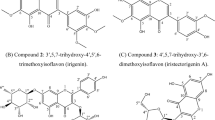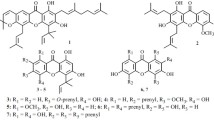Abstract
A new cytoprotective compound, 1-[(4S)-3,4-dihydro-4-hydroxy-2,2-dimethyl-2H-1-benzopyran-6-yl]-ethanone (1) was isolated from the flower buds of Tussilago farfara L. (Compositae), together with eight known compounds, 3,4-dicaffeoyl isoquinic acid (2), trans-cinnamic acid (3), 4-hydroxyacetophenone (4), 4,5-dicaffeoylquinic acid methyl ester (5), 3,5-dicaffeoylquinic acid methyl ester (6), 4-hydroxybenzoic acid (7), isoquercetrin (8), and ligucyperonol (9). Compounds 2–4 were found in this plant for the first time. The isolates 1–9, were tested for their cytoprotective activities against glucose oxidase-induced oxidative stress in mouse fibroblast NIH3T3 cells and human keratinocyte HaCaT cells. Among them, 1 and 3 showed significant cytoprotective activities as determined by MTT assay and lactate dehydrogenase leakage, indicating their possibility as the potent cytoprotective agents. The structure of 1 was determined by spectroscopic data analysis including 1D- and 2D-NMR experiments, and its absolute configuration was elucidated by a circular dichroism.

Similar content being viewed by others
References
Basnet P, Matsushige K, Hase K, Kadota S, Namba T (1996) Four di-O-caffeoyl quinic acid derivatives from propolis. Potent hepatoprotective activity in experimental liver injury models. Biol Pharm Bull 19:1479–1484
Dhanuskodi S, Manikandan S (2005) EPR investigations on γ-irradiated 4-hydroxyacetophenone single crystals. An NLO material. Radiat Eff Defects Solids 160:197–205
Do MH, Kim SN, Seo SY, Yeo EJ, Kim SY (2015) δ-Tocopherol prevents methylglyoxal-induced apoptosis by reducing ROS generation and inhibiting apoptotic signaling cascades in human umbilical vein endothelial cells. Food Funct 6:1568–1577
Fenske NA, Lober CW (1986) Structural and functional changes of normal aging skin. J Am Acad Dermatol 15:571–585
Fukuyama T, Arai M, Matsubara H, Ryu I (2004) Mizoroki–Heck arylation of α,β-unsaturated acids with a hybrid fluorous ether, F-626: facile filtrative separation of products and efficient recycling of a reaction medium containing a catalyst. J Org Chem 69:8105–8107
Gao H, Huang YN, Gao B, Xu PY, Inagaki C, Kawabata J (2008) α-Glucosidase inhibitory effect by the flower buds of Tussilago farfara L. Food Chem 106:1195–1201
Han JT, Bang MH, Chun OK, Kim DO, Lee CY, Baek NI (2004) Flavonol glycosides from the aerial parts of Aceriphyllum rossii and their antioxidant activities. Arch Pharmacal Res 27:390–395
Kil YS, Park J, Han AR, Woo HA, Seo EK (2015) A new 9,10-dihydrophenanthrene and cell proliferative 3,4-δ-dehydrotocopherols from Stemona tuberosa. Molecules 20:5965–5974
Kim MR, Lee JY, Lee HH, Aryal DK, Kim YG, Kim SK, Woo ER, Kang KW (2006) Antioxidative effects of quercetin–glycosides isolated from the flower buds of Tussilago farfara L. Food Chem Toxicol 44:1299–1307
Li W, Huang X, Yang XW (2012) New sesquiterpenoids from the dried flower buds of Tussilago farfara and their inhibition on NO production in LPS-induced RAW264.7 cells. Fitoterapia 83:318–322
Li H, Lee HJ, Ahn YH, Kwon HJ, Jang CY, Kim WY, Ryu JH (2014) Tussilagone suppresses colon cancer cell proliferation by promoting the degradation of β-catenin. Biochem Biophys Res Commun 443:132–137
Liu LL, Yang JL, Shi YP (2011) Sesquiterpenoids and other constituents from the flower buds of Tussilago farfara. J Asian Nat Prod Res 13:920–929
Majer Z, Hollosi M, Levai A, Majerie M, Sujie V (1995) CD spectroscopic study of absolute conformation and configuration of some 4-hydroxychromans. Spectrosc Lett 28:1181–1190
Naya K, Okayama T, Fujiwara M, Nakata M, Ohtsuka T, Kurio S (1990) Sesquiterpenes from the rhizomes of Ligularia dentata Hara. Bull Chem Soc Jpn 63:2239–2245
Ono M, Masuoka C, Odake Y, Ikegashira S, Ito Y, Nohara T (2000) Antioxidative constituents from Tessaria integrifolia. Food Sci Technol Res 6:106–114
Orden AA, Bisogno FR, Giordano OS, Sanz MK (2008) Comparative study in the asymmetric bioreduction of ketones by plant organs and undifferentiated cells. J Mol Catal B 51:49–55
Park HR, Yoo MY, Seo JH, Kim IS, Kim NY, Kang JY, Cui L, Lee CS, Lee CH, Lee HS (2008) Sesquiterpenoids isolated from the flower buds of Tussilago farfara L. inhibit diacylglycerol acyltransferase. J Agric Food Chem 56:10493–10497
Rukachaisirikul V, Khamthong N, Sukpondma Y, Phongpaichit S, Hutadilok-Towatana N, Graidist P, Sakayaroj J, Kirtikara K (2010) Cyclohexene, diketopiperazine, lactone and phenol derivatives from the sea fan-derived fungi Nigrospora sp. PSU-F11 and PSU-F12. Arch Pharmacal Res 33:375–380
San Miguel SM, Opperman LA, Allen EP, Zielinski J, Svoboda KK (2011) Bioactive antioxidant mixtures promote proliferation and migration on human oral fibroblasts. Arch Oral Biol 56:812–822
Sin MK, Kim CM, Ahn DK, Lee KS (1997) Dictionary of Chinese Materia Mediaca. Jungdam, Seoul, p 337
Tanigawa T, Kanazawa S, Ichibori R, Fujiwara T, Magome T, Shingaki K, Miyata S, Hata Y, Tomita K, Matsuda K, Kubo T, Tohyama M, Yano K, Hosokawa K (2014) (+)-Catechin protects dermal fibroblasts against oxidative stress-induced apoptosis. BMC Complement Altern Med 14:133
Wang Y, Hamburger M, Gueho J, Hostettmann K (1992) Cyclohexanecarboxylic-acid derivatives from Psiadia trinervia. Helv Chim Acta 75:269–275
Wu D, Zhang M, Zhang C, Wang Z (2008) Chromones from the flower buds of Tussilago farfara. Biochem Syst Ecol 36:219–222
Yaoita Y, Kikuchi M (1998) Triterpenoids from flower buds of Tussilago farfara L. J Nat Med 52:273–275
Acknowledgments
This research was funded by a Grant (12172MFDS989) from Ministry of Food and Drug Safety in 2014, and was also supported by Global PhD Fellowship Program through the National Research Foundation of Korea (NRF) funded by the Ministry of Education (2012H1A2A1017710).
Author information
Authors and Affiliations
Corresponding authors
Ethics declarations
Conflict of interest
The authors have declared no conflict of interest.
Rights and permissions
About this article
Cite this article
Kang, U., Park, J., Han, AR. et al. Identification of cytoprotective constituents of the flower buds of Tussilago farfara against glucose oxidase-induced oxidative stress in mouse fibroblast NIH3T3 cells and human keratinocyte HaCaT cells. Arch. Pharm. Res. 39, 474–480 (2016). https://doi.org/10.1007/s12272-016-0730-z
Received:
Accepted:
Published:
Issue Date:
DOI: https://doi.org/10.1007/s12272-016-0730-z




